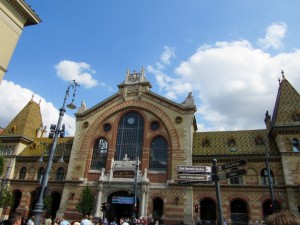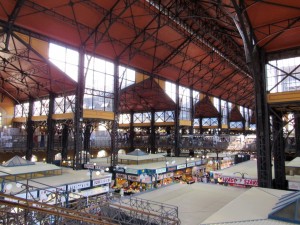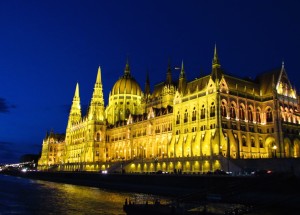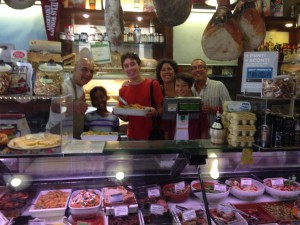This week we had the profoundly sad experience of visiting Auschwitz-Birkenau. While the Jewish experience has been a constant part of our travels, there are no words or even pictures to express what each of us is feeling as result of this visit. Suffice it to say, that being on the ground where so many Jews, Poles, and others were brutally killed is an experience none of us will forget. We end today, as thankful as ever for all that is good in our lives and a bit more conscious of the pain and sorrow of others past and present.
Page 2 of 9
By Noah
On a warm, sunny afternoon, our family left the apartment for a short walk to City Park and the Szechenyi Baths. Built in 1913, it is the biggest and most popular of all the bath houses in Budapest. Szechenyi has 17 different pools that range from a freezing cold ice bath (16 degrees C) to incredibly warm and relaxing natural thermal pools that contain healing minerals known to cure many different diseases and ailments.
Outside there is a very warm thermal pool where you can relax and float; a cold lap/immersion pool to cool off and swim laps; and a medium temperature thermal pool with a lazy river and natural jets shooting up from the bottom. You can go back and forth between the pools cooling down and heating up to achieve maximum comfort mode while outside.
Inside there are 15 types of thermal baths in several different rooms, 6 saunas ranging in heat, smell, and experience, and 4 steam rooms. By the end of the day you are so comfortable and relaxed you just want to fall down and take a nap (which is what we ended up doing when we got home.)
Another incredible thing about this bath is the setting. Szechenyi is located in a beautiful park surrounded by a castle and a lake. Even though the building is only around 100 years old it feels like you have stepped into a time machine and landed in a building from many hundreds of years ago. The baths are surrounded by marble statues and romanesque columns and while looking up you see huge domes in the ceiling decorated with beautiful frescos. Szechenyi is a great experience – I just wish we had a chance to visit some of the other baths in Budapest. I guess that will have to be for our next visit.
By Max
After over five months on the road and with weekly changes of location and accommodations, we have still managed to create a routine of sorts. The good news is that on almost all days, our everyday life involves a good chunk of exploring, learning, and sight seeing. On our recent stop in Budapest, picking a single day to write about was difficult. Already in the first three days we visited an incredible castle and church, the third largest parliament building in the world, and spent a day soaking in 17 different thermal baths and pools. I know the kids will eventually write about some of those visits so I will share about another “typical” day we had that week.
My routine starts each day by getting up a bit earlier than the others to have coffee and catch up on anything I need to do online. Of course, this includes checking the Yankees’ box score and other sports news at ESPN.com before moving on to email and other tasks. Around 8:00 I start waking up my workout partners, Noah and Caleb (and recently Romi, who has started running with us as well!). We don’t always work out together, but on most days the three of us do some type of workout. We have had to be quite creative as we move from apartment to apartment without any equipment. However, we have learned that you can always run, do pushups, jump rope or, if you’re lucky, find a local gym.
On this day, Caleb and I did one of our new favorites; Death by Burpee (http://www.menshealth.com/fitness/death-by-burpee ) or the burpee challenge as we’ve come to call it. This is by far our most challenging workout and involves doing a set of burpees each minute and incrementally adding 1 burpee each set with the eventual goal of reaching a set of 20. Noah is currently our family leader, but Caleb (9 sets) and I (14 sets) are gaining on him.
Next we have breakfast at home and then get ready to head out. This day we knew it was going to be a long one as there was so much we wanted to see. We left our apartment around 9:30 and jumped on the Budapest subway. Our line was built in the late 1800s (the first in Europe) and feels like it has not been updated since then. Our first event this day was a walking tour of Budapest’s Jewish Quarter. In a number of cities we have taken advantage of “free” walking tours. The tours are not really free, but you do get to decide how much you want pay at the end of the tour. We really lucked out with a tour guide who knew much about Hungarian history, the city of Budapest, as well as Jewish religion and culture.
On the tour we learned about the unique experience that Jews had in Hungary prior to World War II. For the most part, Jews in both rural and urban Hungary were able to practice Judaism and hold positions in the private and public sector. Unlike other eastern European countries, Hungarians Jews did not experience pogroms and in many ways thrived in Budapest. One of the greatest achievements of the community was building what is still today the second largest synagogue in the world. Built from 1854- 1859, the Dohany Street Synagogue (also referred to as the Great Synagogue) is still in use today and includes a large memorial garden to the victims of the Holocaust.
Of course, World War II dramatically impacted Jews across Hungary. Early in the war, Jews were protected from deportation by the Hungarian government. However, all of this changed after the Nazi invasion in March 1944. Even though Germany’s defeat was almost certain, the Nazi’s swept through the Hungarian countryside and cities with a particular speed and vengeance. In just eight weeks some 424,000 Jews were deported to Auschwitz-Birkenau. In October 1944, when the Nazi-affiliated Arrow Cross party came to power thousands of Jews from Budapest were murdered along the banks of the Danube and many more marched to the Austrian border. While the Soviet Union put an end to the Holocaust, the rise of Communism in Hungary brought with it a new era of oppression and hardship that impacted the ability of the Jewish community to quickly rebuild itself.
Today the Jewish quarter is a mix of a small, but vibrant Jewish community and a hip food and bar scene that in some instances incorporates Jewish culture. Sprinkled throughout the neighborhood are a number of “ruin pubs”, (pubs built into spaces left from the remains of crumbled old buildings), street food establishments, kosher restaurants, and Judaica shops. We took advantage of this opportunity and had a roving lunch eventually eating at three different establishments to ensure we got our fill of Jewish street food, matzoh ball soup, and hummus!
With full bellies, we walked a few kilometers to the Great Market Hall in search of souvenirs, Hungarian paprika, and believe it or not, more food. The Great Market Hall was built in 1897and has three floors, a top floor filled with souvenir stands, a main floor with produce and spices, and a basement with the “smelly stuff,” both fish and pickled goods.
Even though the day was starting to feel long, we decided we wanted to push through and to take a night cruise on the Danube River that did not start for another 4 hours. After grabbing tickets for the 9:00 pm cruise, we took this opportunity to pop into the nearby Marriott hotel where I passed on one of my traveling secrets to the kids: head to the conference room floor (usually the second floor) as the bathrooms are always huge, clean and often empty. They were not disappointed.
After the Marriott, we stopped for drinks at a ruin pub, and dinner at a food truck (yes, we’re still in Budapest, not Portland), and then it was finally time for our night cruise. Noah had been pushing us do this all week, and we are so glad that we relented. While Budapest is a beautiful city by the day, at night it becomes a jewel. As the second most illuminated city in Europe (after Paris), we stared in wonder at each of the sites from the gigantic Parliament building to the many beautiful bridges that connect hilly Buda on the west side of the river with flat Pest on the east side.
Arriving back at the dock around 10:30 pm we still needed to walk to the subway, take the train, and make the short walk from the stop to our apartment. We literally stumbled into the apartment at 11:15pm after a long and fun day that fed our minds, our tummies, and our senses. “Typical” in many ways, but also very special on its own.
By Sue
For our second week in Italy, we focused on the area in and around Florence. Rather than stay in the city, we rented an apartment in the very small hill town of Poppiano (population 850) – about 30 minutes SW of Florence. Our apartment was up the road from a 12th century castle and in every direction we enjoyed sweeping views of olive groves, vineyards, wheat fields, and pine trees.
In the course of a week we made two trips into Florence, went hiking to the ruins of a medieval town that was devastated by the plague, visited the hill towns San Gimignano and Volterra, and spent a full day in Siena (more on this in Noah’s upcoming post on Il Palio). All of this made possible by Max’s willingness to brave the roads of Tuscany with their hairpin turns, endless blind spots, and crazy drivers.
Italy holds special memories for me as I spent a semester abroad in Florence when I was a college junior. While that was 28 years ago, there are many things from that experience that I carry with me today. It was here that I was bitten by the travel bug and developed a deeper desire to explore, learn and be curious about the world. I am also quickly learning there are a number of things I have forgotten from that experience, including basic conversational Italian and anything related to Renaissance art and history!
Now nearly three decades later I am watching that same spark ignite in the hearts and minds of our children. They have embraced this experience fully and it has been fun watching their wide-eyed enthusiasm for each new stop on the journey. When they lament the lack of time in a certain place or feel sad we aren’t able to make it somewhere we had hoped to visit, I keep reminding them this may be their first venture out into this big, amazing world, but it doesn’t have to be their last. New opportunities await them to witness the diverse ways people live and connect with one another; to be a curious observer and listener; and to feel more a part of this global community than any electronic device or new technology can offer, if they so choose. I look forward to seeing where the journey takes them next.
Noah and Romi found food bliss in Florence. For Noah it was one of the best sandwiches he has eaten on this trip and for Romi, it was daily servings of gelato. Here are their musings on these finds.
By Noah and Romi
We have had a lot of amazing food on this trip – from heaping bowls of meat stew in Ethiopia to big plates of homemade bread and moussaka in Turkey. It has been surprisingly hard, however, to find a really incredible sandwich. Other than döners in Turkey and shawarmas in Israel, we have not found blog worthy sandwiches other places on our trip.
All that changed when we visited Florence, Italy and stumbled upon the All’antico Vinaio sandwich shop right around the corner from the famous Uffizi art gallery. We had just finished a delicious lunch of fresh fish, spaghetti, lasagna, eggplant parmesan, and gelato, but when we saw these sandwiches I knew I needed to get one.
The line for the restaurant was out the door and down the block. After waiting for about 20 minutes it was finally my turn to order. The best part about this sandwich shop was you just tell them what kind of meat you want and they do the rest. They know exactly what kind of cheeses, spreads, and toppings to add and fold it all into warm, fresh focaccia bread. I choose spicy fennel salami and the man behind the counter cut off a TON of meat and assembled the masterpiece with homemade cream cheese, artichoke spread, and grilled eggplants. All for only 5 euros!! After I felt a little sick, but it was all worth it!
Gelato is the Italian version of ice cream, but is much creamier. Almost everyday in Italy we had gelato and went to some really good places. But the best place was Vivoli gelateria in Florence. Even the locals in Florence think this place is one of the best gelaterias.
We decided to have gelato before lunch and started looking for Vivoli, but using google maps took us to the wrong corner. We just kept going straight which led us to a big square. By this time we were getting hungry and decided to eat lunch. We ate outside at a cafeteria run by very friendly people who told us how to get to Vivoli after lunch.
We started walking in the direction they told us and after about three blocks we were lost. We decided to turn on google maps again. This time we found Vivoli and realized that we walked right past it the first time and didn’t notice it before because we were looking at a deli across the street.
They only serve gelato in cups, not cones. I choose half chocolate and half vanilla. They didn’t have my favorite flavor, stracciatella, which is like chocolate chip ice cream so I chose my usual flavors. I wish we were staying in Italy longer because there is so much to do there. Not just eat gelato, but other things too!












































Recent Comments